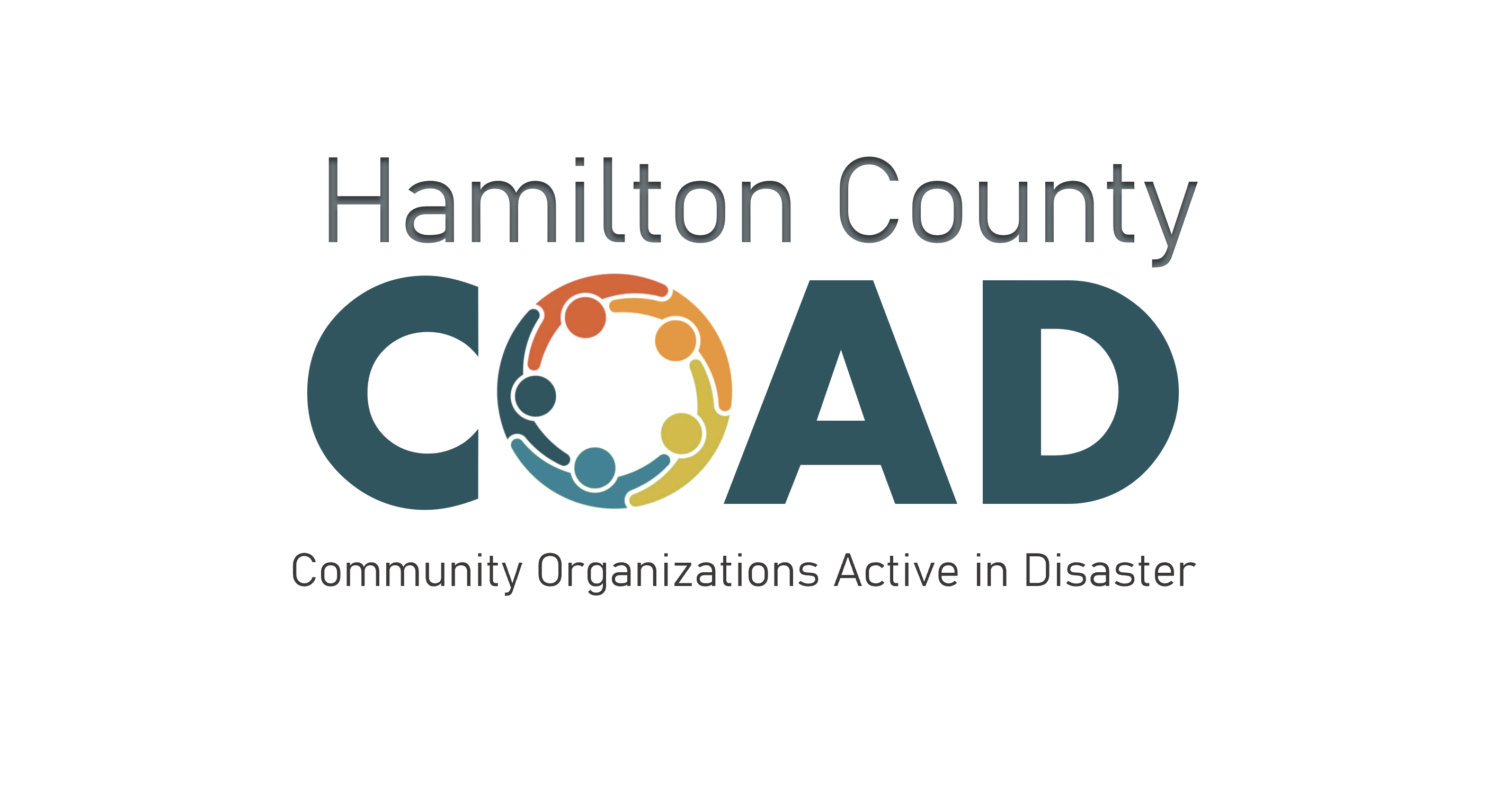
What is the Hamilton County COAD?
The Hamilton County Community Organizations Active in Disaster, or
COAD, is a collaborative group of organizations that want to help our
community before, during, and after a disaster. Similar groups exist
across the United States and play an important role in local disaster
response and recovery. Any non-profits, businesses, faith-based organizations, community
groups, and government partners who want to help Hamilton County in a
crisis are welcome to join.
What does COAD Stand for?
COAD
stands for Community Organizations Active in Disaster. We use this
acronym because COADs are a known structure in the disaster response
field, and we want to use the same naming structure as other local
groups - for example, our neighbors to the north have formed the Miami
Valley Regional COAD.
You may also see the acronym “VOAD” used, which stands for Voluntary
Organizations Active in Disaster. Typically the state or national-level
groups are known as VOADs and local and regional groups call themselves
COADs, but these acronyms are sometimes used interchangeably.
COADs/VOADs have the same goals and purpose, they just might work on
different levels.
What is the Hamilton County COAD?
The Hamilton County Community Organizations Active in Disaster, or
COAD, is a collaborative group of organizations that want to help our
community before, during, and after a disaster. Similar groups exist
across the United States and play an important role in local disaster
response and recovery.
What does the COAD do?
The
Hamilton County COAD itself does not provide services, but its member
organizations do in their respective sectors. The COAD's function is to
proactively bring organizations together so that if disaster strikes,
they already have experience and a framework for working together
effectively.
The COAD gives space for organizations to share their expertise and
amplify the needs of the people they serve. By bringing diverse voices
to the table, the COAD plays a critical role in engaging and advocating
for all community members in disaster preparedness, response, and
recovery efforts
Who can join the COAD?
Any non-profits, businesses, faith-based organizations, community
groups, and government partners who want to help Hamilton County before,
during, and after a disaster are welcome to join. Organizations are
asked to commit to our 4 core principles: cooperation, communication,
coordination, and collaboration, in order to be a member.
Does your organization have to have disaster response experience to join?
No, organizations do not have to have disaster response experience to
join; any group interested in helping and collaborating with other
organizations is welcome to become a member.
What are the benefits of joining?
There is no cost to join the COAD and membership has many benefits, including:
-
Networking opportunities with other community organizations
-
Priority access to information and resources in an emergency response
-
Advocacy opportunities for your sector and your constituents
-
Input on county-level emergency planning and decision making
-
Improved connections with local government partners
-
A role in creating a safer and more resilient community
How much does it cost to join?
There are no costs to join that Hamilton County COAD.
What is the commitment like for COAD members?
Members
are able to be as involved as they would like to be. In times where
Hamilton County is not facing a disaster, there will be biannual
meetings for all members and periodic emails with information, updates,
or opportunities for involvement.
There will be ways for organizations to have more influence in
disaster planning through subcommittee groups (i.e., a Sheltering Task
Force, Pet Care Planning Team, etc.) and participation in optional
surveys and meetings to provide a community perspective for emergency
planning. Members are encouraged to work with other COAD organizations
if they see a need and to communicate with Hamilton County Emergency
Management on projects. Becoming a member does NOT commit an
organization’s resources to a future disaster response. COAD members
always retain the ability to determine their level of involvement.
What will the COAD do in a disaster?
We can't know exactly how a disaster will affect our community, but we
know the COAD will play an integral role in the response. COAD member
organizations will be working in their own sectors and communicating and
collaborating on those efforts within COAD communication channels. The
COAD may also be assembled to aid local emergency managers with
decisions on behalf of the community, or to make decisions as a group on
a disaster response plan impacting multiple member organizations. We
will likely have multiple virtual or in-person meetings and frequent
update emails so we can all work together to address the crisis and move
on to recovery.
How does being in the COAD benefit my specific organization in a disaster?
Hamilton
County EMHSA does not collect donations or accept volunteers, but
communities always offer both in a disaster response. EMHSA will share
the list of COAD members with the public to direct monetary donations
and interested volunteers their way.
As a key disaster response partner, COAD members get priority access
to information about the response that may not yet be public
knowledge. The COAD will help organizations avoid duplication of effort
and help all members effectively provide their services through staying
informed about what else is happening in the community.